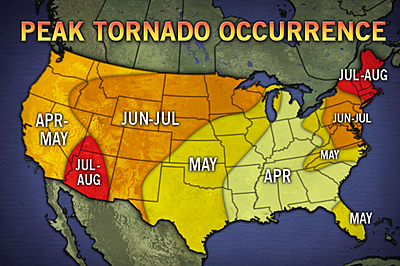Originally posted on ZoomRadar
Severe weather has been relatively quiet across the country since the April 14th tornado outbreak which struck the Great Plains. However, over the past few days things have begun to heat up a little more. Yesterday resulted in over 200 hail reports with 44 of these reports being two inches in diameter or greater. Strong wind gusts also resulted in the death of one and injuries to about 100 people when a large tent was blown over in St. Louis following a Cardinals baseball game.
The number of reported tornadoes has remained fairly low though, with only 44 tornado reports over the past two weeks. With more storms set to rumble for the next few days, it is likely we will add to this number but perhaps not by much. Though Tuesday does appear more favorable and will definitely be something to keep an eye on as it approaches, the parameters needed for another spring tornado outbreak just do not appear to be lining up at this point.
Below is the Storm Prediction Center Day 1 Outlook depicting a slight risk for severe thunderstorms today across portions of eastern Colorado, northeastern New Mexico, the Panhandle of Texas, and parts of Kansas, Oklahoma, and Missouri. The main threats today will be damaging winds, large hail, and a couple isolated tornadoes.
Tomorrow the threat of severe storms targets the eastern portion of the Texas Panhandle, as well as much of Kansas and Oklahoma. Additionally, an area which saw strong to severe storms yesterday, including the southern portions of Illinois, Indiana, and Ohio, will be under the gun again tomorrow as shown in the Storm Prediction Center’s probabilistic Day 2 Outlook below. The main threats yet again are damaging winds, large hail, and a couple isolated tornadoes. The hatched area in the graphic below may even be at risk for some very large hail as steepening lapse rates and instability appear very favorable for this area.
The Day 3 probabilistic outlook from the Storm Prediction Center shows a slight risk area stretching from central Kansas northward to the Minnesota-Canadian border. An elevated slight risk is present in the middle of this slight risk and may be something that needs to be monitored for a moderate risk as the time of this event gets closer. Once again though, damaging winds and large hail will be the main threats though supercells may have a better chance of developing during this time period which may result in a few more tornadoes.
What is limiting the tornado risk you might ask?
The easy answer is a general lack of quality shear in the areas at risk for thunderstorm development. When good shear exists, it has typically been isolated in nature. The next few days seem to show this same trend of a lack of good shear. The issue with the shear is not even so much directional as it is speed. With a weak jet stream and slow low-level jet, thunderstorms will have a hard time finding enough speed shear to get rotating at faster rates, thus limiting the tornado threat. In addition to the limited shear, instability has remained marginal many days with caps not allowing the air to really get rising for thunderstorm development.
Will these limitations break anytime soon?
It appears conditions for tornadoes will become more favorable on Monday night as the low-level jet begins to pick up across the Plains. The best chance, like I said earlier, could be Tuesday into Tuesday night. Take a look at some of the parameters below as depicted by the latest run of the NAM model for Tuesday afternoon and evening.
The image below shows CAPE for Tuesday afternoon. Large areas of 2000 J/kg plus depicted in yellows and reds and even 3000 J/kg plus depicted in reds exist across a large portion of the threat area. With so much energy waiting to be tapped, the question exists now of whether caps will yet again keep this CAPE from being used. It appears this may be the case early on in the day but by the evening and into the early hours of the overnight Tuesday, conditions appear favorable.
Shear may still be an issue though and this is why the number of tornadoes could still be limited despite having enough instability to support thunderstorm development. Surface to 500 mb bulk shear appears somewhat favorable at times over different areas but helicity values remain generally low. The effective helicity index shown below for Tuesday afternoon, appears at least marginally favorable for many areas and alludes to the fact that a few isolated areas will likely be quite favorable.
While the low-level jet does strengthen Tuesday night, it mainly does so over the southern portion of the risk area as depicted below for Tuesday night into Wednesday early morning.
The jet stream on the other hand remains towards the northern portion of the risk area as depicted below for the same time as the above image.
This is the issue for speed shear across the Plains during this period. So while the parameters exist, it appears they will just not line up enough to create a tornado outbreak and therefore as it stands right now, only an isolated threat for tornadoes should be expected. That being said be sure to keep an eye on this event because if that low-level jet strengthens a little more than currently expected or the jet stream drops a little further south, Tuesday evening into Tuesday night could get quite interesting across the northern portions of the elevated slight risk highlighted in the Day 3 Storm Prediction Center outlook.




















































